![Himalayan salt (coarse, [?] up to 5 mm) from Pakistan Himalayan salt (coarse).jpg](http://upload.wikimedia.org/wikipedia/commons/thumb/4/46/Himalayan_salt_%28coarse%29.jpg/220px-Himalayan_salt_%28coarse%29.jpg)
This is a list of minerals, both metallic and non-metallic found in Pakistan province wise.
![Himalayan salt (coarse, [?] up to 5 mm) from Pakistan Himalayan salt (coarse).jpg](http://upload.wikimedia.org/wikipedia/commons/thumb/4/46/Himalayan_salt_%28coarse%29.jpg/220px-Himalayan_salt_%28coarse%29.jpg)
This is a list of minerals, both metallic and non-metallic found in Pakistan province wise.
Minerals are found richly, in all of the Provinces of Pakistan. They may be mined in common locations or regions based on their popularity. Different minerals may also be mined in different regions such as the Hindu Kush, Himalaya, and Karakorum ranges.
| Region | Image | Mineral | Notes | Ref |
|---|---|---|---|---|
| Khushab District |  | Bauxite | The bauxite is best developed from Nilawahn to Khura in the south of the Salt Range . In general the content of alumina and silica has inverse relationship from east to west. | [1] |
| Jhelum District | | Bentonite | It is presently being extracted from Siwalik rocks found near Villages of Jalalpur Sharif and Dina in Jhelum District. Workable deposits also occur in Attock. Sandy terrain of the Pabby Hills near village Tainpur. Dina, Jhelum District have been reported to be the best places where economic deposits of bentonite are found. | [2] |
| Mansehra |  | Calcite | In Punjab, deposits are found in the cracks of limestone in the form of veins. It is found in Attock, Rawalpindi, Chakwal, Jhelum, and D.G. Khan Districts. In Kala Chitta Range in Attock District, calcite is found in abundance in pure form. | [3] |
| Daud Khel |  | Celestine (celestite) | In Punjab, the Celestite occurs as irregular veins over a length of three to four miles to the east and northeast of Daud Khel the mineral occurs in irregular veins. | |
| Rajanpur District, Chakwal District |  | Chalk | Chalk deposits are mainly formed in the limestone accumulation, which can be found in Rawalpindi, Chakwal, Khushab, Mianwali, D.G. Khan and Rajanpur District. | |
| Mianwali District etc. |  | Kaolinite (China clay) | China clay is also found in the Districts of Chakwal, Khushab, Mianwali, Attock and D.G. Khan. | |
| Salt Range |  | Coal | In Punjab Province huge coal deposits are found in the Salt Range. The coal found in Punjab is of sub-bituminous quality. | |
| Regions near Kalabagh (Mianwali District) |  | Dolomite | The main deposits include Barbara deposits of Kuch near Kalabagh in Mianwali District. The Dolomite deposits are also found near Datta Nala (about 11 km North East of Makerwal). Doya-Lunda, Normia and Punnu (Near coal mines of Mulla Khel) and near Buri Khel in Mianwali. | |
| Chakwal District etc. | Fire clay | In Punjab important location of fireclay deposits are Chappri, Dhok Pass, Mouza Bazaar, Musakhel in District Mianwali, Chambal, Padhrar in Khushab, Kruli, Dlawal, Minhala and Wahali in Chakwal District, Khewra, Rohtas, Punan wal and Katha Saghral (District Khushab) and Kala Chitta Range (Bagh Nilab Area, Chhoi Area, Surg Area, Buta Area, Akhori Area) in District Attock. |


Gemstones, also known as semi-precious stones or gems, are minerals widely used in jewelry and for ornamental purposes. Northern and western regions of Pakistan are rich in high quality gemstones. Some of the major gemstones are enlisted below; [4]
The main mining areas of these gems are in Khyber Pakhtunkhwa and Federally Administered Tribal Areas, Gilgit-Baltistan, and Balochistan. [4]
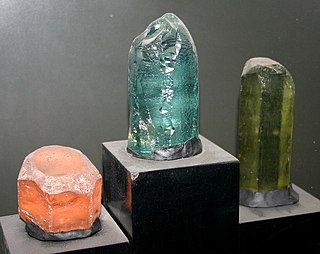
Beryl ( BERR-əl) is a mineral composed of beryllium aluminium silicate with the chemical formula Be3Al2Si6O18. Well-known varieties of beryl include emerald and aquamarine. Naturally occurring hexagonal crystals of beryl can be up to several meters in size, but terminated crystals are relatively rare. Pure beryl is colorless, but it is frequently tinted by impurities; possible colors are green, blue, yellow, pink, and red (the rarest). It is an ore source of beryllium.

Topaz is a silicate mineral made of aluminum and fluorine with the chemical formula Al2SiO4(F, OH)2. It is used as a gemstone in jewelry and other adornments. Common topaz in its natural state is colorless, though trace element impurities can make it pale blue or golden brown to yellow-orange. Topaz is often treated with heat or radiation to make it a deep blue, reddish-orange, pale green, pink, or purple.

Ruby is a pinkish red to blood-red colored gemstone, a variety of the mineral corundum. Ruby is one of the most popular traditional jewelry gems and is very durable. Other varieties of gem-quality corundum are called sapphires. Ruby is one of the traditional cardinal gems, alongside amethyst, sapphire, emerald, and diamond. The word ruby comes from ruber, Latin for red. The color of a ruby is due to the element chromium.

Peridot, sometimes called chrysolite, is a yellow-green transparent variety of olivine. Peridot is one of the few gemstones that occur in only one color.

Turquoise is an opaque, blue-to-green mineral that is a hydrous phosphate of copper and aluminium, with the chemical formula CuAl6(PO4)4(OH)8·4H2O. It is rare and valuable in finer grades and has been prized as a gemstone for millennia due to its hue.
Lustre or luster is the way light interacts with the surface of a crystal, rock, or mineral. The word traces its origins back to the Latin lux, meaning "light", and generally implies radiance, gloss, or brilliance.

Jasper, an aggregate of microgranular quartz and/or cryptocrystalline chalcedony and other mineral phases, is an opaque, impure variety of silica, usually red, yellow, brown or green in color; and rarely blue. The common red color is due to iron(III) inclusions. Jasper breaks with a smooth surface and is used for ornamentation or as a gemstone. It can be highly polished and is used for items such as vases, seals, and snuff boxes. The density of jasper is typically 2.5 to 2.9 g/cm3. Jaspillite is a banded-iron-formation rock that often has distinctive bands of jasper.
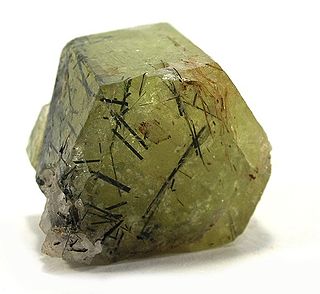
In mineralogy, an inclusion is any material trapped inside a mineral during its formation. In gemology, it is an object enclosed within a gemstone or reaching its surface from the interior. According to James Hutton's law of inclusions, fragments included in a host rock are older than the host rock itself.

Bahawalpur District is a district of Punjab, Pakistan, with capital the city of Bahawalpur. According to the 1998 Census it had a population of 2,433,091, of which 27.01% were urban. Bahawalpur district covers 24,830 km2. Approximately two-thirds of the district (16,000 km2) is covered by the Cholistan Desert, which extends into the Thar Desert of India. The district is a major producer of cotton.
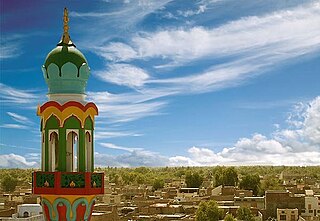
Layyah District, is a district in the Punjab, Pakistan. It is located in the southern part of the province. The city of Layyah is the administrative headquarters of Layyah district. Layyah has a hot semi-arid climate.
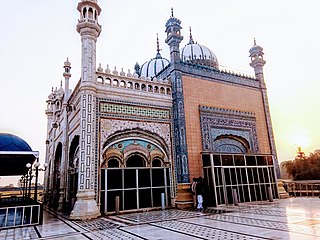
Rahim Yar Khan District, is a district in the province of Punjab, Pakistan. Its headquarters is the city of Rahim Yar Khan.

Bhakkar District, is a district in the province of Punjab, Pakistan. The district was created out of parts of Mianwali in 1982, and has the city of Bhakkar as its headquarters. Part of its area consists of a riverine tract along the Indus, called Kaccha, while most of the district area lies in the desolate plain of the Thal Desert.

Rajanpur is a district of Dera Ghazi Khan Division in the Pakistani province of Punjab, with its administrative headquarters the city of Rajanpur. District of Rajanpur was formerly part of Dera Ghazi Khan District and was created on 1 July 1982. According to the 2023 Pakistani census, the district had a population of 2,323,980.

A rare-earth mineral contains one or more rare-earth elements as major metal constituents. Rare-earth minerals are usually found in association with alkaline to peralkaline igneous complexes in pegmatites. This would be associated with alkaline magmas or with carbonatite intrusives. Perovskite mineral phases are common hosts to rare-earth elements within the alkaline complexes. Minerals are the solid composer of inorganic substances. They are formed through the atomic movement of fluid which can be derived from evaporation, pressure or any physical change. They are mostly determined through their atomic weight. The minerals that are known as 'rare' earth minerals are considered rare due to their unique geochemical makeup and properties. These substances are not normally found in mining affiliated clusters. Thus an indication of these minerals being short in supply and allocated their title as 'rare' earth minerals. Many rare-earth minerals include rare-earth elements which thus hold the same significant purpose of rare-earth minerals. Earth's rare minerals have a wide range of purposes, including defense technologies and day-to-day uses. This would be associated with alkaline magmas or with carbonatite intrusives. Perovskite mineral phases are common hosts to rare-earth elements within the alkaline complexes. Mantle-derived carbonate melts are also carriers of the rare earths. Hydrothermal deposits associated with alkaline magmatism contain a variety of rare-earth minerals. Rare-earth minerals are usually found in association with alkaline to peralkaline igneous complexes in pegmatites.
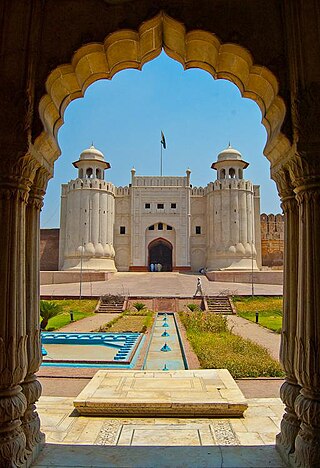
Tourism in Pakistan is a growing industry. In 2010, Lonely Planet termed Pakistan "tourism's 'next big thing'". The country is geographically and ethnically diverse, and has a number of historical and cultural heritage sites. Condé Nast Traveller ranked Pakistan The Best Holiday Destination for 2020 and also declared it the third-highest potential adventure destination in the world for 2020. As security in the country improves, tourism increases; in two years, it has increased by more than 300%.
According to the United States Energy Information Administration (EIA), Pakistan may have over 9 billion barrels (1.4×109 cubic metres) of petroleum oil and 105 trillion cubic feet (3.0 trillion cubic metres) in natural gas (including shale gas) reserves.
Mining is an important industry in Pakistan. Pakistan has deposits of several minerals including coal, copper, gold, chromite, mineral salt, bauxite and several other minerals. There are also a variety of precious and semi-precious minerals that are also mined. These include peridot, aquamarine, topaz, ruby, emerald, rare-earth minerals bastnaesite and xenotime, sphene, tourmaline, and many varieties and types of quartz.

The Pothohar Plateau, also spelled Pothwar, is a plateau in the northern region of Punjab, Pakistan, located between the Indus and Jhelum rivers.

The geology of Pakistan encompasses the varied landscapes that make up the land constituting modern-day Pakistan, which are a blend of its geological history, and its climate over the past few million years.

Aquamarine is a pale-blue to light-green variety of the beryl family, with its name relating to water and sea. The color of aquamarine can be changed by heat, with a goal to enhance its physical appearance. It is the birth stone of March.